A summary of Austin’s 1st Annual Facilitator Summit
As a facilitator, I draw from a diverse set of perspectives. I started my career as a software engineer with a deep curiosity about people and systems. This led me to study process and the impact it has on systems and the humans in them. Through my startup experiences, I’ve seen and tried many things and respect the principles that thread through many frameworks and methodologies. It is this fascination that drives me to experiment with new methods and approaches.
After launching Voltage Control, a workshop agency, I quickly realized that most facilitators are “I-shaped” and not many are “T-shaped.” This means that while they are highly skilled and experienced in their craft, they don’t have expertise in a wide variety of methodologies and frameworks.
This realization led me to design a conference that would break down the silos of facilitation. I also realized that there was the potential to bring together a tribe that had never been assembled. We would move past the guilds and methodology-centric gatherings and convene facilitators of all kinds to build rapport, learn, and grow together.

Now that I had a concept, I needed a name. After much internal deliberation, I settled on “Control the Room.” I liked the idea of playing with the notion of control and what it means—how much do we have, how much do we need, and how much should we let go of? I think it’s the most stratifying characteristic of the facilitation genres. Some approaches are incredibly rigid, and others are looser and flowing. I also liked the tension that this name might create and the discussion that might emerge.
We partnered with MURAL to provide an interactive attendee experience. The Mural allowed attendees to add details about themselves, look up information about the speakers, and submit questions. A few of our speakers even used Mural to collect and synthesize input from attendees. The tool also serves as a lasting artifact of the conference to reflect on the day.
Check out the “Control the Room” Mural boards through the links below.
- Pre-Conference Canvas: See attendees and goals they shared in advance.
- Post-Conference Canvas: See the schedule, speakers, photos, notes, and questions from the day.
“Control the Room was a fast-paced day filled with speakers that offered inspiration as well as practical advice about facilitation. By partnering with Voltage Control to use MURAL throughout the event, we were able to capture and visualize the day and provide attendees with an interactive artifact they can take home and revisit.” —Lindsey Eatough & Bentley Rubinstein, MURAL
Facilitation Master Class: The Workshop(s)



Daniel Stillman and I co-created a master class, and it quickly sold out, so we added an additional day which filled up as well. The groups were super-engaged professionals wanting to level up in a meaningful way. The day’s agenda provided ample time for practitioners to share and learn from each other through facilitated exchanges.
We focused on the Conversation OS, building agendas, Liberating Structures, visual facilitation techniques, icebreakers, energizers, eye-openers, and even allocated time to work on attendee challenges. Attendees especially enjoyed hearing tips on how to manage difficult people, juggle multiple roles, lead group synthesis, and approach groupwork mindfully.
Control the Room: The Conference

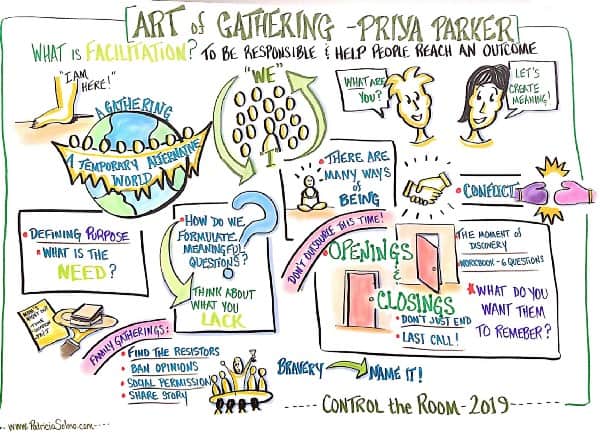
Opening Speaker: Priya Parker
Priya Parker provided a beautiful opening to the day. She started with her definition of a facilitator and engaged participants to discover how it resonated with their own experiences. Her 90-minute talk was a pure delight and received a standing ovation. She is a stratospherically talented facilitator.
Read on for summaries of all “Control the Room” presentations:

Ben Guhin & Marni Wilhite
The idea of working in government may be at an all-time low— the shutdown, the partisanship, the do-whatever-it-takes-to-be-right forcefulness that seems impossible to penetrate. Despite these obstacles, Marni Wilhite & Ben Guhin have established methods for service design, technology strategy, and stakeholder facilitation at the City of Austin that are leading the conversation for how cities design and deliver services.
John Colaroutulo

John’s work is rooted in the MG Taylor visual models for facilitation. These methods came from the work of architecture, and practitioners like John have expanded on them in meaningful ways.
He shared several visual discussion frameworks that he uses and enabled attendees to merge that with their existing skills through a mini-scenario workshop.

Keith McCandless & Anna Jackson
Keith literally wrote the book on Liberating Structures, and Anna brings many years of practice in the field. Liberating Structures is a system of 35 methods with many more in development. The open platform has criteria for assessing and adopting new techniques into the repertoire. Keith and Anna led us through a method under review called “Talking with Pixies” and then had us submit an assessment of the method.
“I loved exploring how to be a leader-facilitator in charge but not in control. Specifying only the tiny, nearly invisible elements that distribute control liberates everyone to work at the top of their intelligence.” — Keith McCandless, Liberating Structures co-author

Daniel Stillman
Daniel Stillman, the founder of The Conversation Factory and author of the Conversation OS, is an expert facilitator and co-created the Control The Room facilitator master class workshop with me. He presented a narrative framework for workshop agenda design. The approach is simple yet powerful—select a narrative structure and use that as a template for your workshop design. It frees you from the default approach of simplifying stringing together a list of activities.
“I really enjoyed the opportunity to connect with an incredibly diverse group of facilitators, not just from Austin, but from around the country and around the world! It’s amazing to find your tribe — people who care about making group conversations work, for everyone involved.”
— Daniel Stillman, founder, the Conversation Factory

Brian Sullivan
Brian reminded us that while facilitators have great tools to “Control the Room,” we must consider the “stuff” to bring into the room. One of these substances is empathy and often that has to be gathered “outside of the room.” He shared his five go-to activities to cultivate this empathy.
- Change Your Perspective
- Limit Yourself
- Do It Yourself
- Similar Experience
- Day-in-the-Life

Heidi Helfand
Heidi Helfand is Director of Engineering, Excellence at Procore Technologies, a leading provider of cloud-based applications for construction and the author of the book Dynamic Reteaming: The Art and Wisdom of Changing Teams. She shared insights on the three levels of listening: Inward Focused, Attention Outward, and Environment. Many of us are stuck in the Inward level, and it’s critical as facilitators to move between all three. Check-in with yourself, your attendees, and read the room. She had everyone practice physical mirroring and paraphrasing.


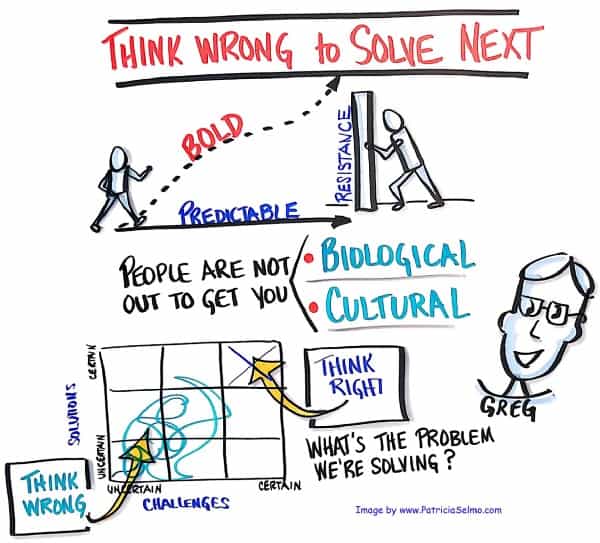
Greg Galle
Greg Galle is an author, entrepreneur, and instigator. His book Think Wrong: How to Do Work That Matters has become a handbook for people who want to invent what’s next for their organizations, communities, and countries. Greg talked about the predictable path and how most people default to thinking and designing with only this in mind. Using a Solutions vs. Challenges 2×2 matrix, he illustrated that if you are exploring solutions and challenges that are both certain or well-known, you are considering the predictable path. He encouraged us to explore the uncertain and welcome the unexpected.

Celine Thibault
Each of us can remember that meeting. The one where everyone is crammed into a stale office, where one person presents for two hours, you struggle to stay focused. Celine showed everyone that the way we plan for and set up our meeting environment determines the outcome.
When we create a physically engaging space where people can close their computer and be a part of a group, we experience an emotional shift and make it possible for people to be vulnerable, to speak up, and to push the work forward.
“We often think of facilitation as one of those talents some people have and others don’t. Years of practice, failure, and reflection taught me facilitation is a craft that we can improve over time. Control the Room brings in inspiring, experienced facilitators who break down facilitation into methods and tools we can practice and build on over time.” —Celine Thibault

Tomasz Borek
Does this sound familiar? You’re standing in front of the people you are about to facilitate and your heart sinks—there’s that person who might give you a hard time. Tomasz shared a framework for identifying, classifying, and dealing with difficult people. His framework categories difficult people into five types: The Leader, The Introvert, The Indecisive, The Know-It-All, and The Negativist. The Leader seeks power, and as facilitators, we can use that information to work with them. The Introvert seeks instruction, and we can provide guidance. The Indecisive seeks safety, and we can provide reassurance. The Know-It-All desires knowledge, and we can leverage expertise to comfort them. The Negativist seeks resistance, and we can involve them to unleash them.

Kevin M. Hoffman
Facilitation is a balancing act. It requires empathy for a group’s interests and capabilities while simultaneously keeping them away from tempting, but unproductive, discussion. The effort and focus needed to maintain that balance varies based on what kind of person you are and what kind of topic or group you’re facilitating.
Kevin uses three spectrums of bias to help people get a sense of their own (or anyone’s) facilitation style:
- Improvisation vs. Scripted
- Drawing vs. Speaking
- Space Filling vs. Space Saving
These spectrums help to assess when a style supports a meeting, or when it needs something different. This brief, but fun, workshop got us thinking about our biases, how they serve us and how they hurt us.

Terrence Metz
Terrence kicked off his prioritization session with a tricky problem that seemed like a simple math problem. The room full of bright people didn’t take long to solve it and find consensus on the “right” answer. The problem was, all but one of us were wildly wrong. He used the problem to drive home that voting is a lousy way to determine truth and an ineffective tool group decision making.
Another lesson was just how easy it is to immediately frame a problem and pick the wrong frame. In this case, the majority of us jumped to the conclusion that this was an easy math problem. It turned out that the issue required a visual model to truly understand.
“If you want to be a leader, a significant leader, of the future, follow us. Can you keep up? Many can, because they trust Douglas, actually, they love his multinational aspirations.” —Terrence Metz, CTO MG Rush
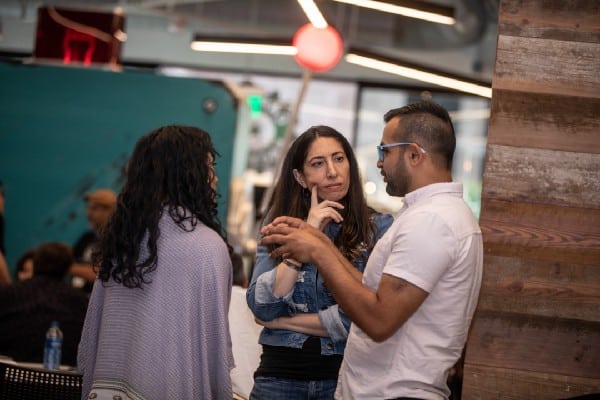

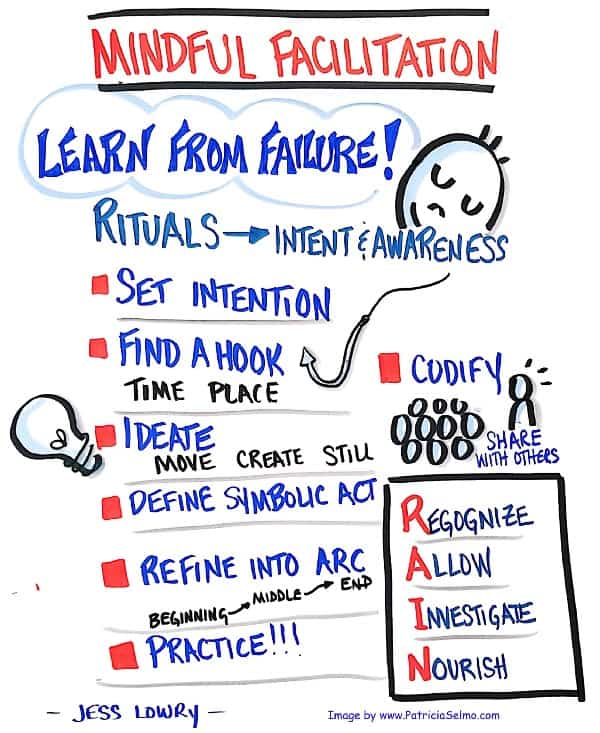
Jess Lowry
We are busy people who pride ourselves in helping our clients achieve their goals. We work hard, and often; we play hard too. Balancing everything can feel impossible and burn out is a reality for most of us. We push ourselves until we hit a point of mental and physical atrophy. We reach for external rewards when what we need comes from within. Jess’s presentation helped us learn and practice techniques to build mindfulness into our daily life to maintain balance.

Mohamed Ali
Mohamed’s Design Thinking Canvas was born from ongoing conversations on how design has an impact, alongside a search for a way to codify a comprehensive approach to design thinking. He takes experiences of forging human bonds through community and used them to structure reminders for clients of that deepest of human needs, the need to love, to be loved, and to relate.
He showed us exercises to use to open workshops, at “lunch & learns,” orientations, or other interactions where we may need to foster a more human connection between people in a room.

Neha Saigal
Too often, teams get stuck optimizing their current operating models and miss out on other business opportunities that might alter the course of an organization. Neha’s workshop proposed a shift in mindset through having a team think more broadly about new market opportunities, promote open exploration, and foster a culture of collaboration.
Whether you’re working with a startup in need of a pivot or with a company in search of new growth mechanisms, this can be a powerful way to bring a team together to explore future possibilities.
Reagan Pugh
As a facilitator, knowing how to draw the stories out of your audience is vital. The highest respect a facilitator can show for their “audience” is to listen to their experiences and tailor the session to meet them where they are.
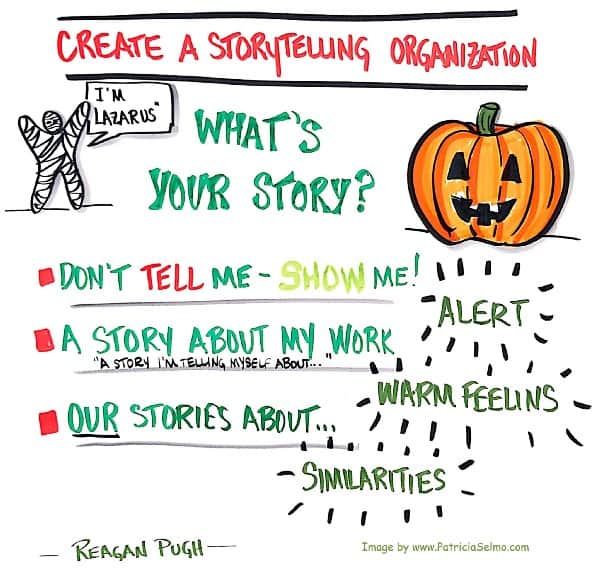
“It’s a powerful thing when you’re able to gather together with people who speak your language. Facilitating is rewarding work, but it can be lonely sometimes when you move from client to client or team to team. Control the Room reminded us we’re not alone in the work we do, and being together served as a source of encouragement to keep doing the good work facilitators do: gathering folks together, guiding them toward clarity, and creating a sense of belonging.” — Reagan Pugh
In Reagan’s session, facilitators were run through the process and framework of “Creating a Storytelling Organization” workshop and walked away with techniques to use for any event where group storytelling might be useful.

Testimonials from Attendees
“It was a real pleasure being in the inaugural Control the Room conference. The experience of learning from other facilitators and expert doers was worth every minute and dollar of investment. I’ll be recommending my team to attend next year.” — Marc Bolick | DesignThinkers Group USA
“As an organizational consultant, orchestrating meaningful conversations to achieve business objectives is of utmost importance. There is a delicate balance between structure and ambiguity; relationships and tasks; and alignment and healthy conflict. Control the Room brought the best-in-class facilitators to share methodologies, tools, approaches, and experiences to elevate my game in facilitation.” —Danny Kim, Organizational Consultant, Centauric
“The structure of this inaugural summit was fast-paced and bookended by two impressive facilitators. As someone who has embraced my role as a 3rd party neutral facilitator for 20 years, I was inspired by my new colleagues’ creative approaches. The conference affirmed that facilitation is both art and science.” — Lynda Baker, Certified Professional Facilitator
“From a stellar keynote by Priya Parker through a diverse set of speakers and practitioners, the first annual Control the Room facilitator summit was a great day for me. I left with an improved frame for how I approach sessions, new techniques for how to execute them, and new connections I look forward to developing. Voltage Control executed the session perfectly — no pressure with 100 facilitators in the room — from the space to the pace, it was exactly what I hoped for as an attendee.”— Scott Sehlhorst
“Relative to other sources of learning, I found it exponentially more valuable to rub elbows with other facilitators where we could talk openly and vulnerably with each other about ways to be better. I found this conference to be much more human than others I’ve attended.” — John Fitch. Cofounder of Committed and author of Time Off
“Douglas delivered a packed agenda with a wide variety of topics that helped expand my current viewpoint on facilitation and why it’s so important in today’s world. His summit resulted in widening my knowledge of current methodologies and deepened my understanding of the current facilitation space.”—Eugene du Plessis, Sr. UX The Home Depot


